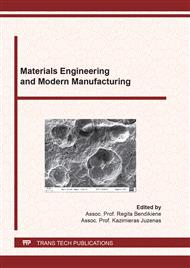[1]
P. Akishin, E. Barkanov, A. Bondarchuk, Finite element modelling and analysis of conventional pultrusion processes, IOP Conf. Series: Materials Science and Engineering. 96 (2015) 012012 10 p.
DOI: 10.1088/1757-899x/96/1/012012
Google Scholar
[2]
E. Barkanov, P. Akishin, R. Emmerich, M. Graf, Numerical simulation of advanced pultrusion processes with microwave heating, In: Proceedings of the VII European Congress on Computational Methods in Applied Sciences and Engineering. IV (2016) 7720-7738.
DOI: 10.7712/100016.2368.5953
Google Scholar
[3]
J. Li, S. C. Joshi, Y.C. Lam, Curing optimization for pultruded composite sections, Compos. Sci. Technol. 62 (2002) 457-467.
DOI: 10.1016/s0266-3538(02)00018-0
Google Scholar
[4]
R.M.L. Coelho, V. M.A. Calado, An optimization procedure for the pultrusion process based on a finite element formulation, Polym. Composite. 23(3) (2002) 329-341.
DOI: 10.1002/pc.10435
Google Scholar
[5]
X. Chen, H. Xie, H. Chen, F. Zhang, Optimization for CFRP pultrusion process based on genetic algorithm-neural network, Int. J. Mater. Form. 3(2) (2010) 1391-1399.
DOI: 10.1007/s12289-010-0684-5
Google Scholar
[6]
C.C. Tutum, K. Deb, I. Baran, Constrained efficient global optimization for pultrusion process, Mater. Manuf. Process. 30(4) (2015) 538-551.
DOI: 10.1080/10426914.2014.994752
Google Scholar
[7]
E. Barkanov, O. Ozoliņš, E. Eglītis, F. Almeida, M.C. Bowering, G. Watson, Optimal design of composite lateral wing upper covers. Part I: Linear buckling analysis, Aerosp. Sci. Technol. 38 (2014) 1-8.
DOI: 10.1016/j.ast.2014.07.010
Google Scholar
[8]
E. Barkanov, E. Eglītis, F. Almeida, M.C. Bowering, G. Watson, Optimal design of lateral wing upper covers. Part II: Nonlinear buckling analysis, Aerosp. Sci. Technol. 51 (2016) 87-95.
DOI: 10.1016/j.ast.2016.01.020
Google Scholar
[9]
E. Barkanov, E. Eglītis, F. Almeida, M.C. Bowering, G. Watson, Weight optimal design of lateral wing upper covers made of composite materials, Eng. Optimiz. 48 (2016) 1618-1637.
DOI: 10.1080/0305215x.2015.1128422
Google Scholar
[10]
E. Barkanov, S. Gluhih, A. Kovalov, Optimal design of the active twist for helicopter rotor blades with C-spar, Mech. Adv. Mater. Struc. 3-4 (15) (2008) 325-334.
DOI: 10.1080/15376490801907855
Google Scholar
[11]
E. Barkanov, A. Kovalov, P. Wierach, J. Riemenschneider, optimised comparative analysis of an active twist for helicopter rotor blades with C and D-spar designs, Mech. Compos. Mater. 5(54) (2018) 553-566.
DOI: 10.1007/s11029-018-9764-2
Google Scholar
[12]
E. Barkanov, P. Akishin, N.L. Miazza, S. Galvez, ANSYS-based algorithms for a simulation of pultrusion processes, Mech. Adv. Mater. Struc. 5(24) (2017) 377-384.
DOI: 10.1080/15376494.2016.1191096
Google Scholar
[13]
E. Barkanov, P. Akishin, E. Namsone, A. Bondarchuk, N. Pantelelis, Real time characterization of pultrusion processes with a temperature control, Mech. Compos. Mater. 2(56) (2020) 135-148.
DOI: 10.1007/s11029-020-09868-4
Google Scholar
[14]
E. Barkanov, P. Akishin, N.L. Miazza, S. Galvez, N. Pantelelis, Experimental validation of thermo-chemical algorithm for a simulation of pultrusion processes. IOP Conf. Series: Journal of Physics: Conf. Series, 991 (2017).
DOI: 10.1088/1742-6596/991/1/012009
Google Scholar


